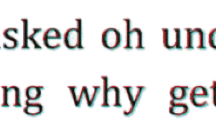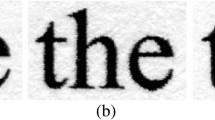Abstract
Authentication of documents can be done by detecting the printing device used to generate the print-out. Many manufacturers of color laser printers and copiers designed their devices in a way to integrate a unique tracking pattern in each print-out. This pattern is used to identify the exact device the print-out originates from. In this paper, we present an important extension of our previous work for (a) detecting the class of printer that was used to generate a print-out, namely automatic methods for (b) comparing two base patterns from two different print-outs to verify if two print-outs come from the same printer and for (c) automatic decoding of the base pattern to extract the serial number and, if available, the time and the date the document was printed. Finally, we present (d) the first public dataset on tracking patterns (also called machine identification codes) containing 1,264 images from 132 different printers. Evaluation on this dataset resulted in accuracies of up to 93.0 % for detecting the printer class. Comparison and decoding of the tracking patterns achieved accuracies of 91.3 and 98.3 %, respectively.














Similar content being viewed by others
Notes
If one source uses more than one color laser printers, the questioned document has to be compared to several base patterns instead of just one.
Roughly speaking, these classes can be assigned to different manufacturers.
The dataset can be downloaded from https://madm.dfki.de/downloads-ds-mic.
Some sets are not complete, others have extra pages, e.g. printer configuration pages.
References
Ali GN, Chiang P-J, Mikkilineni AK, Allebach JP, Chiu GTC, Delp EJ (2005) Intrinsic and extrinsic signatures for information hiding and secure printing with electrophotographic devices. In: Proceedings of the international conference on digital printing technologies, New Orleans, September, pp 511–515
Amidror I (2002) A new print-based security strategy for the protection of valuable documents and products using moire intensity profiles. In: Proceedings of SPIE optical security and counterfeit deterrence techniques IV [1], pp 89–100
Breuel TM (2001) A practical, globally optimal algorithm for geometric matching under uncertainty. Electron Notes Theor Comput Sci 46:1–15
Breuel TM (2003) Implementation techniques for geometric branch-and-bound matching methods. Comput Vis Image Underst 90(3):258–294
Ball GR, Stittmeyer R, Srihari SN (2010) Writer verification in historical documents. In: Proceedings of SPIE document recognition and retrieval XVII, vol 7543, San Jose, January, pp 1–8
Breuel TM (2008) Binary morphology and related operations on run-length representations. In: Proceedings of the 3rd international conference on computer vision theory and applications, Funchal, January, pp 159–166
Chen S, Srihari S (2006) A new off-line signature verification method based on graph. In: Proceedings of the 18th international conference on pattern recognition, Hong Kong, August, pp 869–872
Choi J-H, Im D-H, Lee H-Y, Oh J-T, Ryu J-H, Lee H-K (2009) Color laser printer identification by analyzing statistical features on discrete wavelet transform. In: Proceedings of the 16th international conference on image processing, Cairo, November, pp 1505–1508
Electronic Frontier Foundation (2010) Docucolor tracking dot decoding guide. http://w2.eff.org/Privacy/printers/docucolor/ (accessed on 14.05.2010)
Hails J (2004) Criminal evidence. Thomson, Learning
Hampp NA, Neebe M, Juchem T, Wolperdinger M, Geiger M, Schmuck A (2004) Multifunctional optical security features based on bacteriorhodopsin. In: Proceedings of SPIE optical security and counterfeit deterrence techniques V [2], pp 117–124
Jiang W, Ho ATS, Treharne H, Shi YQ (2010) A novel multi-size block Benford’s law scheme for printer identification, Shanghai, September, pp 643–652
Khanna N, Mikkilineni AK, Chiu GTC, Allebach JP, Delp EJ (2008) Survey of scanner and printer forensics at Purdue university. In: Proceedings of the 2nd international workshop on computational forensics [3], pp 22–34
Mikkilineni AK, Chiang P-J, Ali GN, Chiu GTC, Allebach JP, Delp EJ (2005) Printer identification based on graylevel co-occurrence features for security and forensic applications. In: Proceedings of SPIE security, steganography, and watermarking of multimedia contents VII, vol 5681, San Jose, February, pp 430–440
MIT Media Lab (2009) Initiative to stop the use of tracking dots. http://www.seeingyellow.com (accessed on 18.12.2009)
Otsu N (1979) A threshold selection method from gray-level histograms. IEEE Trans Syst Man Cybern 9(1):62–66
Pu D, Ball GR, Srihari SN (2009) A machine learning approach to off-line signature verification using Bayesian inference. In: Proceedings of the 3rd international workshop on computational forensics, Lecture notes in computer science, vol 5718, The Hague, August, pp 125–136
Sauvola J, Pietikainen M (2000) Adaptive document image binarization. Pattern Recogn 33(2):225–236
Schomaker L, Bulacu M (2004) Automatic writer identification using connected-component contours and edge-based features of uppercase western script. IEEE Trans Pattern Anal Mach Intell 26(6):787–798
Shannon CE (1948) A mathematical theory of communication. Bell Syst Tech J 27:379–423, 623–656
Schomaker L, Bulacu M, Franke K (2004) Automatic writer identification using fragmented connected-component contours. In: Proceedings of the 9th international workshop on frontiers in handwriting recognition, Tokyo, October, pp 185–190
Schreyer M (2009) Intelligent printing technique recognition and photocopy detection for forensic document examination. In: Proceedings of Informatiktage, vol S-8, Bonn, pp 39–42
Schulze C, Schreyer M, Stahl A, Breuel TM (2008) Evaluation of graylevel-features for printing technique classification in high-throughput document management systems. In: Proceedings of the 2nd international workshop on computational forensics [3], pp 35–46
Schulze C, Schreyer M, Stahl A, Breuel TM (2009). Using DCT features for printing technique and copy detection. In: Proceedings of the 5th international conference on digital forensics, Orlando, January, pp 95–106
Shafait F, Keysers D, Breuel TM (2008) Efficient implementation of local adaptive thresholding techniques using integral images. In: Proceedings of SPIE document recognition and retrieval XV, vol 6815, San Jose, January, pp 681510–681510
Smith PJ, O’Doherty P, Luna C, McCarthy S (2004) Commercial anticounterfeit products using machine vision. In: Proceedings of SPIE optical security and counterfeit deterrence techniques V [2], pp 237–243
Tweedy JS (2001) Class characteristics of counterfeit protection system codes of color laser copiers. J Am Soc of Quest Doc Exam 4(2):53–66
van Beusekom J, Schreyer M, Breuel TM (2010) Automatic counterfeit protection system code classification. In: Proceedings of SPIE media forensics and security XII, San Jose, January
van Beusekom J, Shafait F, Breuel TM (2010) Combined orientation and skew detection using geometric text-line modeling. Int J Doc Anal Recogn 13(2):79–92
van Renesse R (1995) Ordering the order, a survey of optical document security features. In: Proceedings of SPIE conference on practical holography IX, San Jose, February, pp 268–275
van Renesse R (1997) Paper based document security—a review. In: European conference on security and detection, London, April, pp 75–80
van Renesse R (2002) Hidden and scambled images—a review. In: Proceedings of SPIE optical security and counterfeit deterrence techniques IV [1], pp 333–348
van Renesse R (2006) Protection of high security documents—developments in holography to secure the future market and serve the public. In: Proceedings of Holo-Pack.Holo-Print, Vienna, November
van Renesse RL (2002)Proceedings of SPIE optical security and counterfeit deterrence techniques IV, vol 4677, San Jose, January
van Renesse RL (2004) Proceedings of SPIE optical security and counterfeit deterrence techniques V, vol 5310, San Jose, January
van Renesse RL (2008) Proceedings of the 2nd international workshop on computational forensics, Lecture notes in computer science, vol 5158, Washington, August
Author information
Authors and Affiliations
Corresponding author
Rights and permissions
About this article
Cite this article
van Beusekom, J., Shafait, F. & Breuel, T.M. Automatic authentication of color laser print-outs using machine identification codes. Pattern Anal Applic 16, 663–678 (2013). https://doi.org/10.1007/s10044-012-0287-5
Received:
Accepted:
Published:
Issue Date:
DOI: https://doi.org/10.1007/s10044-012-0287-5




